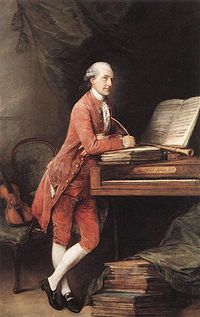Annotation:Fisher's Minuet: Difference between revisions
No edit summary |
m (Text replacement - "garamond, serif" to "sans-serif") |
||
| Line 1: | Line 1: | ||
=='''Back to [[{{BASEPAGENAME}}]]'''== | =='''Back to [[{{BASEPAGENAME}}]]'''== | ||
---- | ---- | ||
<p><font face=" | <p><font face="sans-serif" size="4"> | ||
'''FISHER'S MINUET'''. English, Minuet (3/4 time). G Major. Standard tuning (fiddle). AB. The melody was included in a surprising number of late 18th century American musicians' manuscript collections and copybooks, from Henry Beck's c. 1786 flute commonplace book to J. Williams (Salem, New York) c. 1799 commonplace book for his clarinet. Printed versions can be found in Robert Shaw's ''' The Gentleman's Amusement''' (printed in Philadelphia by Benjamin Carr in 1794), Edward Riley's '''Flute Melodies''', vol. 2 (New York, 1817), and George Willig's '''New and Complete Preceptor for the Fife''' (Baltimore, 1826). | '''FISHER'S MINUET'''. English, Minuet (3/4 time). G Major. Standard tuning (fiddle). AB. The melody was included in a surprising number of late 18th century American musicians' manuscript collections and copybooks, from Henry Beck's c. 1786 flute commonplace book to J. Williams (Salem, New York) c. 1799 commonplace book for his clarinet. Printed versions can be found in Robert Shaw's ''' The Gentleman's Amusement''' (printed in Philadelphia by Benjamin Carr in 1794), Edward Riley's '''Flute Melodies''', vol. 2 (New York, 1817), and George Willig's '''New and Complete Preceptor for the Fife''' (Baltimore, 1826). | ||
<br> | <br> | ||
| Line 15: | Line 15: | ||
</blockquote> | </blockquote> | ||
</font></p> | </font></p> | ||
<p><font face=" | <p><font face="sans-serif" size="4"> | ||
''Source for notated version'': | ''Source for notated version'': | ||
<br> | <br> | ||
<br> | <br> | ||
</font></p> | </font></p> | ||
<p><font face=" | <p><font face="sans-serif" size="4"> | ||
''Printed sources'': Wilson ('''A Companion to the Ball Room'''), 1816; p. 164. | ''Printed sources'': Wilson ('''A Companion to the Ball Room'''), 1816; p. 164. | ||
<br> | <br> | ||
<br> | <br> | ||
</font></p> | </font></p> | ||
<p><font face=" | <p><font face="sans-serif" size="4"> | ||
''Recorded sources'': <font color=teal>The earliest sound recording of the tune is on the 3rd Barrel, 10th tune, of a mechanical Chamber Barrel Organ [http://www.firedragon.com/~kap/Langshaw/], hand-built by John Langshaw (1718-1798), Organ Maker, Lancaster, c. 1785. The organ is one of three surviving Langshaw organs. </font> | ''Recorded sources'': <font color=teal>The earliest sound recording of the tune is on the 3rd Barrel, 10th tune, of a mechanical Chamber Barrel Organ [http://www.firedragon.com/~kap/Langshaw/], hand-built by John Langshaw (1718-1798), Organ Maker, Lancaster, c. 1785. The organ is one of three surviving Langshaw organs. </font> | ||
</font></p> | </font></p> | ||
Revision as of 12:39, 6 May 2019
Back to Fisher's Minuet
FISHER'S MINUET. English, Minuet (3/4 time). G Major. Standard tuning (fiddle). AB. The melody was included in a surprising number of late 18th century American musicians' manuscript collections and copybooks, from Henry Beck's c. 1786 flute commonplace book to J. Williams (Salem, New York) c. 1799 commonplace book for his clarinet. Printed versions can be found in Robert Shaw's The Gentleman's Amusement (printed in Philadelphia by Benjamin Carr in 1794), Edward Riley's Flute Melodies, vol. 2 (New York, 1817), and George Willig's New and Complete Preceptor for the Fife (Baltimore, 1826).

The melody was not only popular in America, but was celebrated in Britain and Ireland as well. It was the composition of Johann (sometimes John) Christian Fischer [1] (1733-1800), a German oboist and composer living in London, and, from 1780, a member of (the largely German) chamber ensemble to George III's spouse, Charlotte of Mecklenburg-Strelitz. According to singer and actor Micheal Kelly (c. 1762-1826) it was 'all the rage' in Dublin about 1770 [see Kelly's Reminiscences, p. 4]. Mozart composed "Twelve Variations in C on a Menuett of Johann Christian Fischer" for keyboard (K 179). Composer, singer and actor Charles Edward Horn (1786-1849) records in Memoir of Himself [ed. by Michael Kassler, 2003, Ashgate Publishing Limited]:
However, one summer afternoon I was rehearsing my variations when my father's return to London unexpectedly brought him to the door accompanied by Fisher, the celebrated oboe player who was in the King's band, and the very same person who composed the Minuetto called 'Fisher's minuet' and danced by the royal family [and] all the celebrated dancers of that day. This event determined my becoming a musician....
Source for notated version:
Printed sources: Wilson (A Companion to the Ball Room), 1816; p. 164.
Recorded sources: The earliest sound recording of the tune is on the 3rd Barrel, 10th tune, of a mechanical Chamber Barrel Organ [2], hand-built by John Langshaw (1718-1798), Organ Maker, Lancaster, c. 1785. The organ is one of three surviving Langshaw organs.
